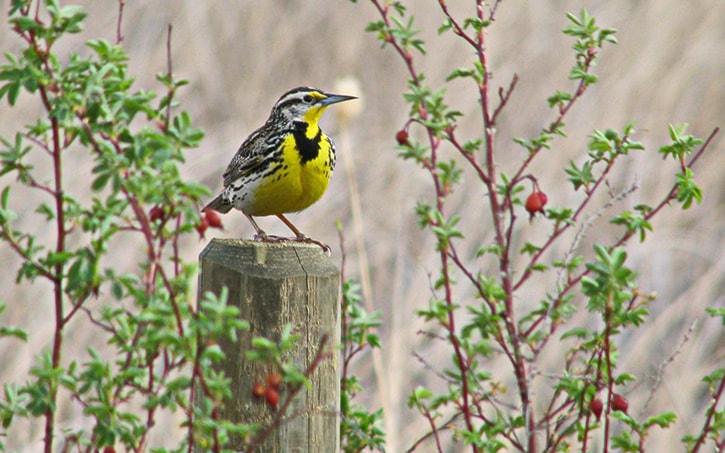Since May is the month of the local and very successful Meadowlark Festival I thought it might be of interest to readers to learn a bit more about meadowlarks – the iconic Okanagan Valley bird that heralds spring’s arrival.
The meadowlark seen here in the valley is the Western Meadowlark – Sturnella neglecta – as opposed to the Eastern Meadowlark found in Ontario and eastward. Meadowlarks are distinctively marked birds with a bright yellow throat, chest and belly and a prominent black v-shaped band just below the throat. Even more noticeable is the bubbling, flute-like song which you will invariably hear before you see the bird. Perched on anything higher than the ground – a fence post, telephone pole, tree or sagebrush – male meadowlarks sing for hours on end as they proclaim their territory and seek out a mate; in fact a male Western Meadowlark usually has two mates at the same time.
Meadowlarks are just slightly bigger than a starling – in fact its genus name Sturnella means “starling-like”. The species name “neglecta” comes about because James Audubon who first named this bird thought that most settlers in the west overlooked this bird. While not readily apparent from their bright colour, Meadowlarks are a member of the blackbird family as are another colourful group – the Orioles.
Meadowlarks are primarily birds of drier, open native grasslands but also frequent other open fields such as rangeland and agricultural fields. They are not so common in orchards, vineyards and such. The two best places to see them near Penticton are the White Lake area (take White lake Rd and stop just past the observatory) and the grasslands just below the cliffs on the east side of Vaseux Lake. At this time of year you are guaranteed to hear meadowlarks singing in these localities.
Meadowlarks may or may not be migratory depending on where they live. All Canadian meadowlarks (both Western and Eastern) are migratory whereas those that live somewhat further south are non-migratory. Their year-round range extends to about the US-Mexican border. During the winter, the northern birds migrate south but only to the southern US and northern Mexico, unlike most songbirds which migrate to the tropics.
One of the earliest studies of the meadowlark diet took place in California in 1914 to determine whether they ate enough grain to be declared an agricultural pest. In spring and summer their food mostly consists of such things as beetles, ants and grasshoppers whereas they eat mostly seeds during the fall and winter. Like other members of the blackbird family, they feed using a process called “gaping”. They insert their closed beak into the soil or bark and then force their jaws open, thus making a hole from which to extract their prey.
Although still numerous, nesting studies show that western meadowlark populations have been slowly decreasing at the rate of about one percent per year over the last 40 to 50 years. Meadowlarks nest on the ground so they are susceptible to damage from cattle grazing and hay mowing.
The South Okanagan Naturalists’ Club next meets on May 22nd at the Penticton United Church hall. This will be our last monthly meeting until September. The speaker is local biologist Lisa Scott who has been leading the battle against invasive plants for close to two decades in the Okanagan and Similkameen Valleys. The challenges of managing invasive species have grown exponentially in recent years as new invaders such as zebra and quagga mussels, and the tiny, but extremely aggressive European fire ant invade our valley. Come learn about the myriad of species that are unwelcome in our region, and what you can do to prevent their arrival and spread. The meeting starts at 7PM. Non-members are welcome.
Bob Handfield is President of the South Okanagan Naturalists’ Club but the views expressed here are his own and not necessarily those of the Club.
